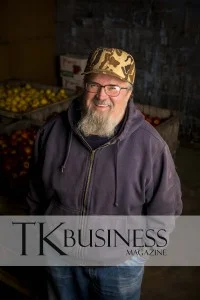From Farm to Table
Photos by JD Melton
But for many years, our daily sustenance has been something not to be savored but instead to be served fast, whether it’s a meal passed to us in a drive-through sack or a box mix entrée prepared on a stove top. The expediency to which we’ve become accustomed has had a high cost, including diminished curiosity about where our food comes from and a lack of confidence in cooking from scratch.
A flourishing nationwide farm-to-table movement is countering the culture of convenience. Bustling farmers’ markets have moved beyond sweet corn and tomato stands to become expansive Saturday morning entertainment destinations. Fine dining establishments are creating culinary alchemy with intoxicating combinations of herbs, fruits and vegetables. Here at home two entrepreneurs and two farmers share how they are helping people in northeast Kansas elevate their appreciation of their food’s origins and their enjoyment of the meals they eat.
Farm-to-Table-RowHouse-2
At the RowHouse Restaurant, patrons might find proprietor Greg Fox snipping basil from the backyard garden for a seasonal signature cocktail or preparing an entrée embellished with a just-right ratio of ingredients both predictable and wholly unexpected.
Fresh herbs are paramount in Fox’s kitchen, “the best way to flavor anything,” he said. “The most exciting time for us is when we get to snip herbs.” Greg Fox enjoys team camaraderie as much as his patrons enjoy the dining experience.
Since opening his restaurant 11 years ago, Fox has been a proponent of locally sourced food. He often attends the Capitol Farmers’ Market on Wednesdays, sometimes picking up Rees Fruit Farm apple cinnamon doughnuts that he converts into toasted panko crumbs, bread pudding and croutons sprinkled on salads.
Growing up with a backyard garden, Fox learned early the satisfaction of “eating tomatoes right off the stem and salads with all their crunchy, zippy, tangy flavors.”
His mom, a former lunch lady who made chili, cinnamon rolls and other cafeteria staples at Assumption Grade School, piqued Fox’s interest in the culinary arts.
“She was a great cook and made everything from scratch, and that’s what we do here at the RowHouse,” he said.
Each course Fox serves, from a two-bite savory starter to a trio of bite-sized sweets to end the meal, is artfully arranged with careful attention paid to color and composition as well as taste.
With an evolving menu of American and European favorites and vegetarian variations like cauliflower meatloaf and mushroom meatballs, the RowHouse has cultivated a clientele comprising regulars as well as curious diners seeking a culinary experience not offered by chain restaurants.
“We used to have to do a little more coaching with some customers who were reluctant to get out of their comfort zone, but now they keep coming back because they know we’ll take care of them,” Fox said.
The RowHouse also caters to tourists looking for unusual experiences in the capital city and offers an assortment of Kansas craft beers.
“We always use local merchants when we can because buying from those homegrown businesses helps stimulate our economy,” said Fox.
The RowHouse Restaurant, 515 Van Buren, serves lunch Monday through Friday and dinner Wednesday through Saturday by reservation.
Farm-to-Table-The-White-Linen-1
Adam VanDonge loves to listen to Mozart, Sinatra, and Beethoven as he puts his culinary school and country club training to work preparing entrees as pleasing to the eyes as they are to the palette.
The chef and owner of The White Linen, Topeka’s newest fine dining establishment, grew up on a farm in Soldier where he did chores and tended the family’s vegetable garden.
“My grandmother canned apples, peaches, pears and other things,” he said. “She made huge meals from scratch. At a young age, the importance of fresh food as an expression of love and nourishment was embedded on my heart and soul.”
Farm-to-Table-The-White-Linen-5
After working in restaurants in other communities, VanDonge returned to Holton and opened an upscale sandwich shop featuring five unconventional but equally scrumptious daily options—chicken and waffles, ham with sweet potato puree and marshmallow cream—along with five soups and salads. In the back room, he periodically offered sold-out seven-course dinners with unusual offerings like bone marrow and mussels through his Drum Room enterprise.
A fan of farmers’ markets “and anything fresh,” VanDonge has scallops, halibut and other fish flown in for The White Linen’s rotating monthly menu. He also revels in experimenting and discovering new things he can incorporate into his menu like watermelon radishes with bright pink centers.
VanDonge has a no-waste policy so radishes, carrot peels, leek tops and the leaves of brussels sprouts are dehydrated and made into seasoning powders. Having realized his lifelong dream to open his own gourmet restaurant, VanDonge’s focus on fresh food prepared with unexpected flourishes is just one facet of his role. He wants to not only elevate the ambience of sharing an exquisite meal with family and friends in the unique setting of the historic Columbian building at 112 S. Sixth Ave. but also to expose diners to selections and spices they might not have encountered before.
Farm-to-Table-The-White-Linen-4
“In December, we offered an 8 ounce filet as an entrée, and I had black truffles from Italy flown in from my supplier in New York,” he said. “I shaved the truffles on the steaks right at the table. Most of the people dining that night had never tasted truffles, so that prompted a conversation.” As a child, VanDonge and his brother often shot rabbits that their father would fry in a skillet on the stove. VanDonge’s grown-up take is to braise the childhood favorite “with garlic, white wine and onions so that the meat falls off the bone.”
“When you’re raised on a farm, you appreciate where food comes from,” he said. “You understand when you’re picking strawberries by hand how delicate they are and appreciate how hard they are to grow. People have become accustomed to eating processed food instead of fresh food, and my goal is to show them what they’ve been missing.”
The White Linen is open Wednesday through Saturday from 5 to 9 p.m. Reservations are required.
The inspiration for Oatie Beef struck Dallas Picolet as he watched a television commercial touting the health benefits of a humble bowl of oatmeal.
Farm-to-Table-Oatie-Beef-1
He wondered whether the same food that lowers cholesterol and promotes health in humans could be used as a diet staple for cattle.
He conducted research, finding only a snippet of advice on the subject in an old Kansas State University textbook warning that feeding oats to breeding heifers could make them too fat.
“I worked with a food processor I knew to educate myself on what cattle would need for protein and then came up with my own ratio of oatmeal and alfalfa,” said Picolet, a third-generation farmer.
He fattened up calves with his formula and then had beef samples tested in a Kansas State University lab in 2007 and again in 2013. The meat consistently had higher protein and Vitamin B12 levels and lower cholesterol and sodium than grass-fed and grain-fed beef, ground turkey, ground chicken, pork, and bison. Most surprising? The minute steaks had less fat than a skinless chicken thigh.
Since his 2007 epiphany, Picolet and his two daughters and sons-in-law have changed their family business model to sell meat to customers in grocery stores, online, at Herman’s Meat & Smokehouse and at farmers’ markets in Topeka, Olathe, Manhattan, Lenexa and Geary County Hospital. They also deliver products to Bon Appetit Management Co., the Payless ShoeSource café, the Stowers Institute for Medical Research and the Kauffman Center.
Farm-to-Table-Oatie-Beef-3
Picolet enjoys bantering with fellow vendors and educating curious customers about Oatie Beef as much as he likes tending his herd.
“I like to introduce myself to customers and talk about why I think our beef tastes better,” he said. “The next time I see them coming toward me at a farmers’ market there are a few seconds when I wonder whether they liked it, but usually they tell me that it was the best steak or roast they’ve ever eaten.”
Picolet and his family’s commitment to quality, consistency and a price point parallel with top-line offerings at grocery stores has enabled Oatie Beef to establish its niche in the marketplace.
Proud of the health benefits of his lean beef, Picolet continues to research trends and belongs to a Facebook group of people whose diets consist exclusively of meat and water.
“When people buy meat in a grocery store, they don’t know what that cow’s been fed,” he said, “but with our beef, they know.”
Oatie Beef ships steaks, roasts, jerky, snack sticks, beef bacon and more nationwide through oatiebeef.com.
Farm-to-Table-Rees-1
Rees Fruit Farm has been providing fruits and vegetables to people in northeast Kansas since 1901 and continues to evolve as trends shift.
In the early decades of the farm’s operation, Rex Rees, third-generation owner, said customers canned produce so they would have access to seasonal favorites throughout the year. In the 1960s and 1970s, preserving and packaging techniques and transportation methods improved so much that just about any item needed to satisfy a craving could easily be purchased in a grocery store in or out of season.
Yet Rees Fruit Farm has still retained its niche as a produce purveyor because many people like to buy local.
“Other countries don’t have the same restrictions and regulations to comply with that we do in the United States,” he said. “Overall, it’s generally safer to buy locally. The only drawback to that is that people need to realize that not all fruits and vegetables are available year round.”
For example, the season for sweet corn is about three weeks and for tomatoes about six weeks, Rees said.
“In Kansas, we’re limited by our climate,” he said. “It would be great to have a longer growing season without extreme temperatures, but that’s the way it is.”
Best known for its orchards, Rees Fruit Farm sells cider, apple butter and apple cinnamon doughnuts made fresh daily. In the summer, individuals and families converge on the fields to pick their own strawberries, blackberries and tart cherries.
The increasing popularity of farmers’ markets has expanded Rees Fruit Farm’s footprint with Wednesday and Saturday participation at the Capitol and the Kansas Judicial Center, respectively, April through October, and at other markets too.
“Going to farmers’ markets is trendy whether people are there to buy a week’s worth of vegetables or just to browse or buy one thing,” said Rees. “We see more vendors there every year.”
Rees said 15 years ago farmers’ markets were viewed primarily as an opportunity for farmers to offload surplus produce, but now the shift is to sell “the best stuff” there.
“The farmers’ markets have become a big part of our business,” he said.
Undaunted by long hours, hard work and the weather uncertainty that farming entails, Rees said he loves growing things and looking for new ways to market the results of his labor.
“The most satisfying thing about this business is that we’ve developed a lot of loyal customers over the years and continue to pick up new ones,” he said.











